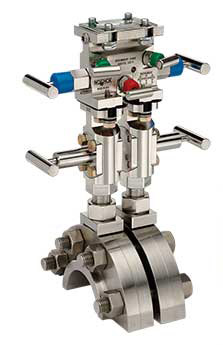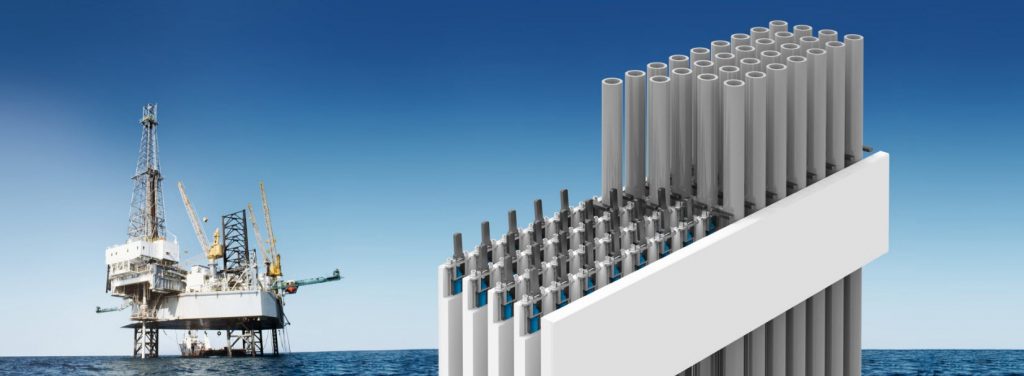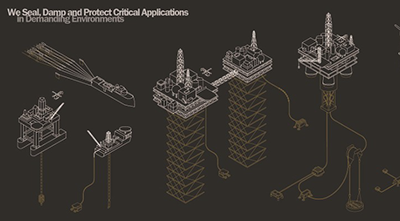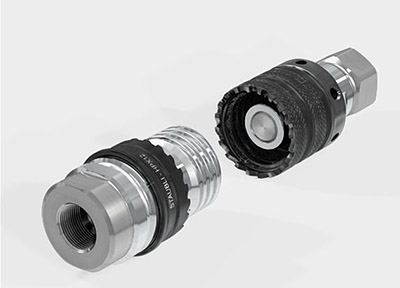This week’s Offshore Technology Conference (OTC) in Houston is a milestone event. The first OTC was held 50 years ago—May 19-21, 1969 in Houston. The conference has been held in Houston each year since and grown annually in terms of size as well as worldwide participation. OTC 2018 opened with a series of special events on April 30 to recognize the commitment of the people and companies who have helped the conference reach this milestone.
OTC is always a big endeavor for the attendee, as it stretches out over a huge area that includes NRG Park. Attendance was heavy today in the main hall, but decidedly lighter in the other exhibition spaces. In general, there was a feeling among manufacturers that the oil and gas segment is still reeling, with no huge upside coming soon—although a few people commented that their businesses were doing fine.
Here are some highlights from what we saw during our quick visit:
 NOSHOK Inc., at Booth #2905, is showcasing products for the oil & gas industry, including low pressure transmitters for vapor recovery applications, hammer union transmitters, and stabilized and non-stabilized connectors (with and without integral valve).
NOSHOK Inc., at Booth #2905, is showcasing products for the oil & gas industry, including low pressure transmitters for vapor recovery applications, hammer union transmitters, and stabilized and non-stabilized connectors (with and without integral valve).
They are also featuring their proven vibration- and chemical-resistant pressure gauges, hazardous location transmitters, intrinsically safe submersible liquid level transducers, needle and manifold valves including flare pattern and 90° angle manifold valves, and FM & CSA approved explosion-proof RTDs.
The NOSHOK Direct Connect Assembly (at right), keeps the meter close to the orifice taps for accurate flow measurements.
 Festo Corp., located in the busy German Pavilion, has introduced a pneumatically based Fingerboard-latching system for drill-rig tubulars that safely indicates the exact locked or open position of each latch. This system operates reliably in harsh water- or land-based drilling environments and eliminates hard to maintain wire harnesses and electronic sensors on Fingerboards. The company is giving live demonstrations of the system.
Festo Corp., located in the busy German Pavilion, has introduced a pneumatically based Fingerboard-latching system for drill-rig tubulars that safely indicates the exact locked or open position of each latch. This system operates reliably in harsh water- or land-based drilling environments and eliminates hard to maintain wire harnesses and electronic sensors on Fingerboards. The company is giving live demonstrations of the system.
Interestingly, the solution was developed using the company’s Industry 4.0-based VTEM Motion Terminal. VTEM is the world’s first digital pneumatic system, where downloadable apps create an almost unlimited number of functions. A single motion terminal can replace 50 different hardware components based on its combination of apps.
The VTEM Motion Terminal with Fingerboard-latch app measures the position of each latch from closed to 100% open by analyzing cylinder air pressure and flow. The system can display measurements graphically via human machine interface (HMI) or communicate to a supervisory controller. Each VTEM smart valve in this application replaces two ordinary pneumatic valves for a 50% savings in the number of values utilized.
The Fingerboard solution also features cylinder seals enhanced for extended life in the specific environment where the rig will be located and a long-wearing corrosion-resistant coating that covers the exterior of each cylinder.
“We’ve had considerable feedback from companies in the drilling industry that unlatched tubulars such as drill pipes and casings are an ongoing safety challenge,” said Craig Correia, Director, Process Industries, North America, for Festo. “When you try to solve this safety challenge by installing electronic sensors and associated wiring 75 feet or more above the deck, they must be robust enough to handle extreme temperature swings, impervious to highly corrosive environments, and explosion-proof. All are difficult requirements for a reliable and serviceable electronic-based system … it’s a new solution that I hope OTC attendees will stop by to see in action.”
 Bosch Rexroth is getting attendees into their booth (#2805) to see its Rally Simulator ride. The 15-minute ride—powered by electromechanical actuators—gives a demonstration of the company’s system design experience as well as its contribution to the simulation industry.
Bosch Rexroth is getting attendees into their booth (#2805) to see its Rally Simulator ride. The 15-minute ride—powered by electromechanical actuators—gives a demonstration of the company’s system design experience as well as its contribution to the simulation industry.
Once off the ride, attendees can check out the benefits of hydraulic and electronic technology with a combined servo-hydraulic system in the Three-Axis Trinity demo. This demonstration utilizes a servo-hydraulic actuator (SHA) that simultaneously brings three different servo axes in motion. The Three-Axis Trinity leverages the advantages of both hydraulic and electronic technology, allowing easy start up and opening the door for Industry 4.0 capabilities.
Primary benefits of the electromechanical drive are:
• High precision and dynamics
• Simple engineering and quick implementation
• High stiffness of the system allows easy control
Primary benefits of the servo hydraulic drive include:
• High thrust force due to hydraulic actuation
• Robustness due to the long lifetime and low sealed fluid volume
• Overload protection via pressure relief valves
Another interesting new product is the Subsea Valve Actuator (SVA), an electro-mechanical actuator with a hydrostatic drive, uniquely designed to complete the range of traditional hydraulic and all-electric subsea actuators for subsea control and production systems.
Optimized for manufacturing, the SVA system is based on industrial-standard components that has been produced with the highest quality standards and lean production methods. With its modular design, users can easily configure according to their unique applications without costly redesigning their entire system.
Highlights of the SVA include:
• An energy efficient system, in accordance with the Rexroth 4EE standard, minimizing the required peak and stand-by electric power
• Compatible with Industry 4.0 technology, the SVA includes integrated sensors for monitoring position, pressure, temperature, and more
• Cost-effective modular design using industrial components and lean production management processes
• Environmentally-friendly set up with redundant pressure compensation and no fluid leakage
• Up to 75% reduction in comparison to all-electric actuators available in the market
• High availability and condition monitoring designed to operate up to 25 years with minimum maintenance
• Independent safety control has Safety Integrity Level 3 capabilities
The SVA actuator achieves the same performance in terms of safety but with much better reliability than hydraulic actuators, by also offering a simple electric interface like the all-electric actuators (without umbilicals for hydraulic fluid power).
 Trelleborg Sealing Solutions, Booth 3227, has received approval for 25 materials to American Petroleum Institute API-16C specification relative to oil and gas choke and kill valve requirements. This represents the largest number of materials compliant to the standard available from any seal manufacturer.
Trelleborg Sealing Solutions, Booth 3227, has received approval for 25 materials to American Petroleum Institute API-16C specification relative to oil and gas choke and kill valve requirements. This represents the largest number of materials compliant to the standard available from any seal manufacturer.
The API-16C range of compliant sealing materials is particularly suited for applications including rotating disc-type, adjustable, barrel-type and orifice choke valve types. The API-16C compliant materials include polytetrafluoroethylene (PTFE) based, PEEK and elastomeric compounds, such as Hydrogenated Nitrile Butadiene Rubber (HNBR), Fluoroelastomer (FKM) and Perfluoroelastomer (FFKM).
“Approval of sealing materials to the API-16C standard is vital in supporting oil & gas choke valve manufacturers. The large portfolio includes a variety of types of sealing compounds, meaning that seal performance in any given choke valve application can be fully optimized, to effectively manage wellbore pressure and maintain flow control,” said Eric Bucci, Trelleborg Sealing Solutions Segment Manager Oil & Gas Americas.
 Over at the Staubli booth, #3009, quick connect couplings are the main draw. Some of the innovative solutions on display at the Stäubli booth include:
Over at the Staubli booth, #3009, quick connect couplings are the main draw. Some of the innovative solutions on display at the Stäubli booth include:
• HPX non-spill quick couplings are suitable for heavy duty, high pressure hydraulic applications. A screw locking mechanism with outer ratcheting collar guarantees robust connections, even if subjected to intense pulsating or vibrating cycles.
• Optional colored alloy caps allow instant visual identification of circuits.
• Clean break, robust and easy to handle, SPX quick couplings are suitable for hydraulic connections in challenging environments. A non-spill flush face design ensures that no air enters the circuits. The couplings are also environmentally friendly, as they prevent the escape of contaminants into the work area.
• The compact design and automatic locking of CBX quick couplings makes them suitable for repeated, blind or hard-to-access connections. They can be connected under residual pressure (PA option) and fitted with protective dust caps. With its anti-pollution design, the CBX range can be a solution for hydraulic circuit connections. CBX couplings are spill-free to ensure the operator safety and flat faced to guarantee the integrity of fluids.
• Flat face NCB quick couplings allow non-spill, clean break disconnections, while the coupling’s internal design offers excellent flow rate. Along with standard automatic locking, the NCB is also available in a screw-on version for on-board applications.
Filed Under: News, Slider